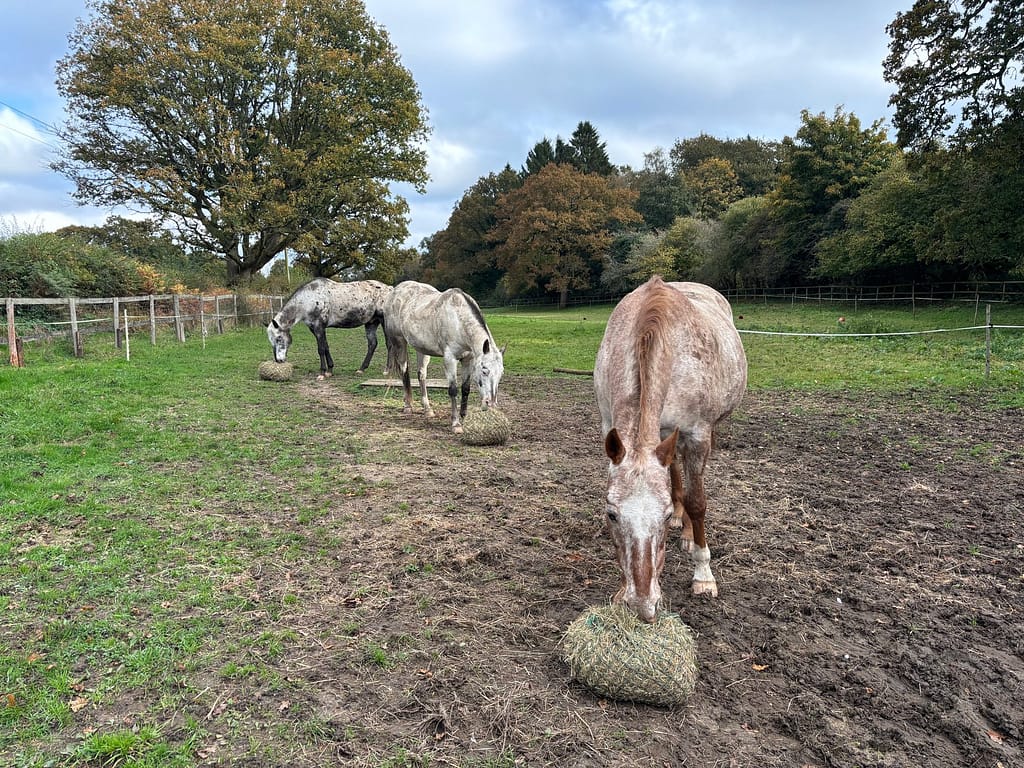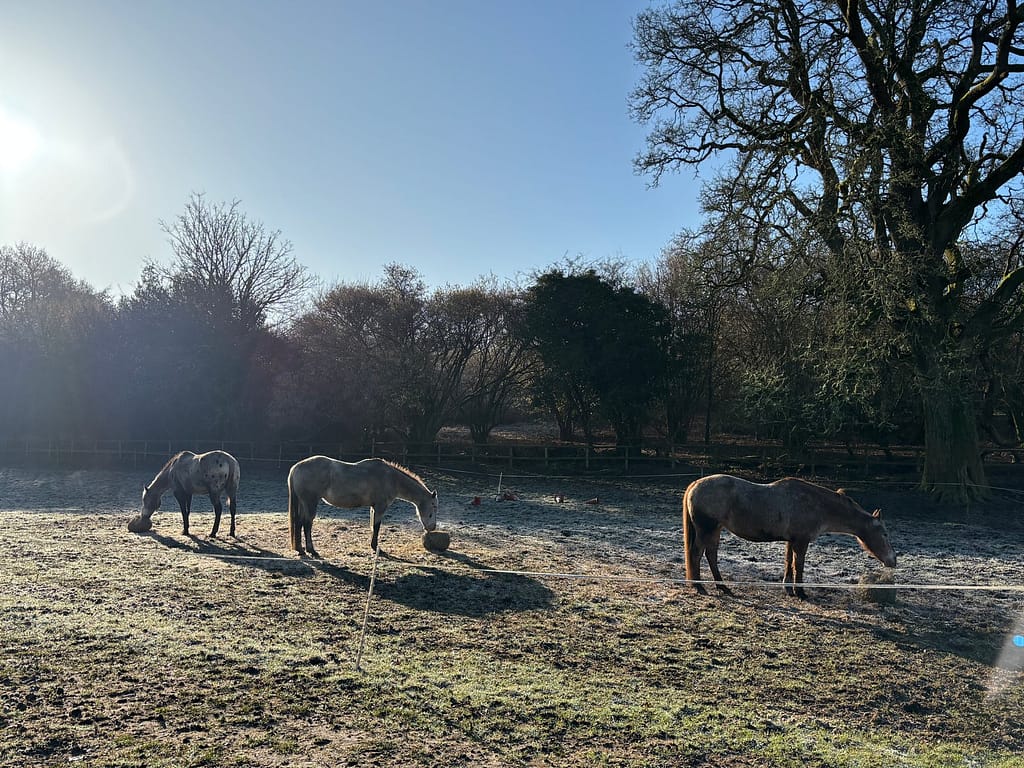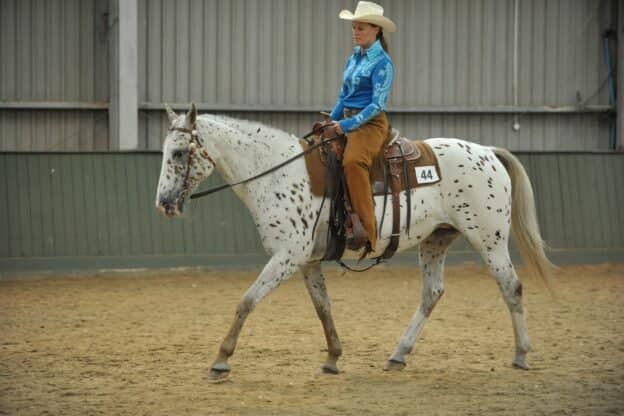As an Iridologist the standout problem I see in the horses eyes most often is an unhappy digestive system. Maintaining a horse’s digestive health is a critical aspect of overall well-being
Horses have a unique and complicated digestive system. Their small stomach is only the size of a rugby ball designed to process food in 30-90 minutes, so big infrequent meals will destroy the reflex to empty the stomach causing discomfort and potential health problems. The food then spends the next 40-90 minutes travelling through the small intestine being mixed with bile and enzymes, then things get a bit more interesting when the food gets to the hind-gut which is a huge fermentation vat full of bacteria and micro-organisms which process the remaining fibre to provide nutrition and energy.
In order for this all to function optimally, they need a constant trickle of fibrous food, simply put, they NEED long grass and herbs, often described as standing hay, and meadow hay as well as access to salt, water and movement.
We, as horse-owners/guardians spend most of our time and money finding feeds and supplements that we hope will help our equine partners’ gut to function better.
In order to do so it’s important to understand that a horses gut doesn’t work like ours, or indeed like other grazing animals. It’s also important to recognize that horses are actually not grazers but foragers. They are designed to walk miles a day picking at largely extremely fibrous and low nutrient food like bark, herbs, bits of trees and long seedy grass. Short green grass, particularly Rye grass, haylage and many of the widely available bags of feed that we generally find in the UK will cause dysbiosis (an imbalance) in the gut.

Digest these simple facts:
- Horses cannot assimilate foods like soft grass and roots and fruits which contain too much pectin.
- Horses cannot assimilate more than a tablespoon of fat a day! Instead, it gets excreted through the skin giving the impression of a lovely shiny coat (it was used as an old ‘selling’ trick). Put more technically their liver cannot make glucose from fat because ketone pathways are not good in horses.
- Horses are poor at regulating blood glucose and lipids, or food with sugar or digestible starch in, such as bagged feeds, rye grass hay, grain etc.
So, how can we provide what they need:
The simple answer is 24/7 turnout and ad-lib hay!
When I heard this I did what I am sure you are doing now. I freaked out slightly!
I realise that I am extremely lucky to have a field where my 3 Appaloosa’s run as a small herd, they have a barn that has two entrances so no-one can get trapped, and where they can get out of the rain or heat or whatever. Downside is, the field is VERY wet all winter, which seems to have been all year this year! I also created a semi-track system which allows me to rest parts of it so the grass can grow, to segregate the wet parts in the winter to preserve the horse’s hooves.
I can choose to open areas when the grass is long and therefore more fibrous. The outer track makes them walk or sometimes gallop around it, and it borders onto woody areas which they happily spend their time landscaping the trees and bushes that overhang.
What if you are in a livery yard that limits hay or turn-out?
This is a difficult one. A lot of livery yards are getting more switched on to turning suitable horses out together, and some are converting to a track system, which lends itself to ad-lib hay and better movement.
However, if your horse has to be stabled a lot, I recommend you use several small-hole hay nets which take longer to run out. There are many other enrichment ideas, but they will be the subject of another blog.
What if your horse/pony has gut dysbiosis already, or has had regular food withheld in the past. Or perhaps they have a metabolic condition that stops them self-regulating?
Soaking hay for just 20-25 minutes will get rid of most of the sugar and it is not long enough to allow the build-up of pathogenic bacteria. Hopefully you can slowly introduce them to ad-lib feeding, but…
You may need to get creative
- First of all, MOST horses will self-regulate…they may stuff themselves with ad-lib hay for the first 2-3 days and waddle around with big tummies, BUT after the initial ‘whoopee FOOD’ reaction, you will find that once they know is always food available they won’t get grumpy with you or each other. They will spend more time chilling, sleeping and hanging out together, creating a healthier social dynamic within the herd.
- Large bales of unsprayed meadow hay work well if you can get them under cover, failing that, normal small hole hay nets kept full and hung around the barn and field also works well.
- You could take your horse for a herb walk if there aren’t many hedgerows or diversity in their paddock. Just go out for a walk and allow them to munch at different herbs, trees and grasses along the route. Not only are they self-medicating and getting enrichment but they are also spending time with you in a positive way which inspires confidence and creates a partnership. Horse’s will only pick at what they need and sometimes it is just the smell or the essence of the plant that they will take.
- If your horses are barefoot, instead of feeding them an actual feed in the mornings, give them a small hay net tied into a ball with the tie threaded back through the net and pop them in the field. The horses then have a great time pushing and rolling them around, eating the hay as they go. It looks a bit like dribbling a football, so we call them nose-balls! What this achieves is getting their heads close to the ground in a ‘natural grazing ‘ position and they are getting some enrichment too as they are walking around. This method is only suitable for barefoot horses, you can’t do this if your horse is shod in case they get caught up.

I love supplementing my horses food with herbs, and thanks to doing an online course with www.animalbotanical.co.uk I have learnt so much about using herbs that are readily available and free! I just have to go and find them and offer them to the horses. It is very satisfying and interesting to see what the horses pick and observe how much healthier they’ve become. The course is called Herbal Shenanigans, which is all about seasonal herbs, foraging and self-selection.
Just to add, before you think that I have the perfect herd set-up and a trouble free horse life… I don’t! I have absolutely been where some of you are now. I’ve felt completely overwhelmed and in despair.
Pre-covid I was out there riding western and showing. Then, during 2020 I tore the meniscus in my knee, then in 2021 my beautiful red mare Prairie got diagnosed with Equine Metabolic Syndrome which I have been managing ever since. Ozzie, my brown Fewspot has been retired with genetic issues since he was 8 years old. I showed him in-hand and he was a superstar! But he can never be ridden. Ozzie is the Boss and without ad lib feed will resource -guard. Last but not least, Charro my Black Leopard spot had his training interrupted by Covid, then due to my injury and inability to restart it he is still a paddock ornament, semi-feral and a very special boy!

My references are: Dr Christina Fritz from Sanoanimal.eu or the UK contact is Coppermead Equestrian. (Lorraine Dearnley)
And Rachael Maxwell from Animal Botanical for all things herb!
For those interested in learning more, I offer iridology consultations to help assess your horse’s health and provide tailored recommendations. For further information please visit my website www.equine-insight.co.uk.




